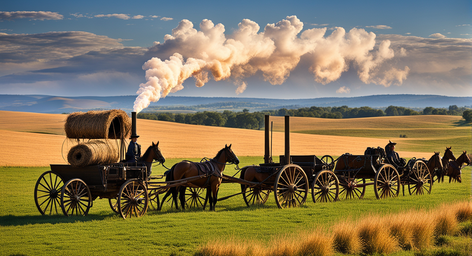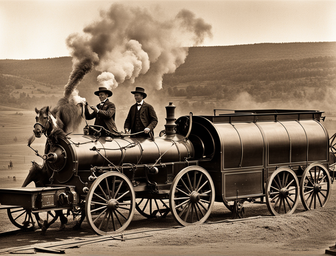What New Technology Was Spawned by Westward Expansion
The westward expansion of the United States during the 19th century was not merely a geographical phenomenon; it was a pivotal era that birthed a wave of new technologies that transformed industries, communication, and daily life. This period of expansion, fueled by the pursuit of new opportunities and resources, served as a catalyst for innovation, leading to the creation of various technologies that shaped the future.
Introduction to Westward Expansion
As settlers moved westward, driven by the promise of land and prosperity, they encountered challenges that demanded inventive solutions. This migration led to a surge in technological advancements, sparking changes in various sectors.
Impact on Technological Innovation
The expansion into new territories created an environment ripe for experimentation and innovation. The demand for tools, equipment, and transportation spurred inventors to develop solutions that could overcome geographical barriers and facilitate exploration.
Early Technological Advancements
Tools and Equipment
Pioneers relied on innovative tools to carve out new settlements in untamed lands. Innovations in plows, axes, and other farming implements made agricultural pursuits in challenging terrains more feasible.
Transportation
The need for efficient transportation to navigate vast distances led to the evolution of modes like the Conestoga wagon and the stagecoach, revolutionizing travel across the expanding territories.
Communication and the Telegraph
The introduction of the telegraph revolutionized communication, connecting the distant corners of the country. The telegraph's invention by Samuel Morse significantly reduced the time it took to relay information, transforming how people communicated across long distances.
Role in Connecting the West
The telegraph played a pivotal role in bridging communication gaps, enabling the rapid transmission of information crucial for trade, commerce, and even personal correspondence.
Agricultural Innovations
Advancements in Farming Machinery
The expansion spurred the development of innovative farming machinery, such as the reaper and thresher, revolutionizing agricultural practices and increasing productivity.
Irrigation Systems
To harness the potential of arid lands, pioneers engineered intricate irrigation systems, allowing cultivation in regions previously deemed inhospitable.
Mining and Industrialization
Extractive Technologies
The pursuit of valuable resources in the West spurred advancements in mining technologies, leading to the development of more efficient extraction methods.
Impact on Industrial Revolution
The resources acquired from the West fueled the burgeoning Industrial Revolution, supplying raw materials crucial for industrialization.
Railroads and Expansion
Transcontinental Railroad
The construction of the transcontinental railroad marked a significant achievement, linking the East and West coasts, facilitating trade, and transforming cross-country travel.
Influence on Trade and Commerce
The railroad's completion expedited trade and commerce, fostering economic growth and altering the landscape of industries.
The Impact of Westward Expansion on Innovation
Economic Growth and Innovation
The convergence of diverse resources and the influx of new ideas spurred economic growth and further innovation in various sectors.
Social and Cultural Transformations
The westward expansion led to societal and cultural transformations, as diverse communities interacted, exchanged ideas, and contributed to a rich tapestry of innovations.
what new technology was spawned by westward expansion
Technology is always evolving, and sometimes it takes a specific event to trigger a new wave of innovation. The westward expansion of the United States is a perfect example of this. The settlers that headed west were looking for a new life, and they needed technology that could help them survive in the harsh conditions. This led to the development of new types of transportation, weaponry, and even housing. One of the most important pieces of technology to come out of the westward expansion was the covered wagon. This was a sturdy, reliable way to transport people and goods across the country. It was also fairly easy to build, which made it a popular choice for settlers. Covered wagons were instrumental in helping settlers reach their destination safely. Another important piece of technology that was developed during the westward expansion was the Colt revolver. This gun was much more reliable than previous weapons, and it was also much easier to carry. This made it a popular choice for both settlers and law enforcement. The Colt revolver helped to make the West a much safer place. Finally, the last piece of technology that was spawned by the westward expansion was prefabricated housing. This type of housing was quickly assembled and could be easily
The Telegraph
The transcontinental railroad
The barbed wire fence
The Windmill
TheHomestead Act
The eight-hour work day
The Granger movement
The telegraph
The telegraph was a new technology that was spawned by westward expansion in the United States. The telegraph was used to communicate between two points over long distances. The telegraph was invented in 1837 by Samuel Morse. The telegraph was used during the American Civil War to communicate between the Union and Confederate armies. The telegraph was also used to build the transcontinental railroad in the United States.
The transcontinental railroad
With the invention of the steam engine in the early 19th century, it became possible to build a railroad that could span the entire continent. In 1869, the first transcontinental railroad was completed, connecting the eastern and western United States. The transcontinental railroad revolutionized travel and commerce, and spurred the development of new technologies such as refrigerated cars, which made it possible to transport perishable goods long distances.
The barbed wire fence
The barbed wire fence was first built in 1876 by Michael J. Kelly. It was made of two wires twisted together and had sharp barbs every few inches. The fence was originally built to keep cattle from straying onto farmland. However, it quickly became clear that the barbed wire fence was also effective at keeping people from crossing borders. During the late 1800s, the barbed wire fence became increasingly popular as a way to demarcate property boundaries. In some cases, the fence was used to keep people out of areas that were off-limits, such as mining claims. In other cases, the fence was used to keep people in, such as on Native American reservations. The barbed wire fence was also used as a tool of war. During the American Civil War, both Union and Confederate troops used barbed wire to fortify their positions. In the 1870s, the U.S. Army used barbed wire to build forts in the West to protect settlers from Native Americans. The barbed wire fence has had a profound impact on the American West. It has helped to shape the landscape and the way that people live. The fence is a symbol of both the opportunities and the dangers of westward expansion.
The Windmill
In 1854, Daniel Halladay received a patent for the windmill, a device that harnesses the power of the wind to generate rotational energy. The windmill became an essential tool for farmers in the American West, who used it to pump water and grind grain. The windmill was first invented in Persia and later introduced to Europe in the 12th century. It wasn't until the 19th century that the windmill began to be used for agricultural purposes. In America, the windmill was seen as a way to harness the power of the natural world to benefit humanity. The windmill allowed farmers to irrigate their fields and grow crops in arid environments. It also made it possible to grind grain into flour, which was essential for baking bread. The windmill was a crucial tool for the settlers of the American West, and it played a vital role in the development of the region.
TheHomestead Act
When most people think of the Homestead Act, they think of the way it allowed for free land in the western United States. But the Homestead Act was much more than that. The Homestead Act was also responsible for a number of new technologies that were spawned by westward expansion. One of the most important new technologies to come out of the Homestead Act was the barbed wire fence. Before barbed wire, fence-building was a slow and labor-intensive process. But with barbed wire, fence-building became much quicker and easier. This made it possible for ranchers to fence in their cattle, which helped to prevent rustling. Another new technology that was spawned by the Homestead Act was the windmill. Windmills were used to pump water from wells, which was essential for homesteaders in arid regions of the West. Windmills were also used to generate electricity, which was a new and exciting technology at the time. Yet another new technology that was made possible by the Homestead Act was the telephone. Before the telephone, the only way to communicate over long distances was by telegraph. But the telephone made it possible for people to speak to each other directly, which was a big improvement. So, while the Homestead Act is best known for giving free land to homesteaders, it also played a role in the development of new technologies that were essential to the Westward Expansion.
The eight-hour workday
The eight-hour workday is a product of the Industrial Revolution and the rise of the labor movement. It is a cornerstone of the modern economy and has been adopted by countries around the world. The Industrial Revolution brought about a dramatic increase in the productivity of factories and other workplaces. This led to a decline in the need for workers and a corresponding decline in wages. In response, workers began to demand shorter hours and higher wages. The eight-hour workday was first proposed by the labor movement in the 19th century. It was seen as a way to improve the working conditions of workers and to make their jobs more bearable. The eight-hour day quickly gained popularity and was adopted by many countries. The eight-hour workday has had a profound impact on the world economy. It has made it possible for people to work fewer hours and to enjoy more leisure time. It has also made it possible for more people to enter the workforce and has helped to drive economic growth.
The Granger movement
The Granger movement was a populist movement that arose in the late 19th century in the United States. It was fueled by the economic hardships faced by farmers in the aftermath of the Civil War and the rise of the railroads. The Grangers fought for better rates for shipping farm products and for government regulation of the railroads. They also sought to improve the quality of life for rural Americans. To this end, they formed cooperative businesses, such as grain elevators and cooperative creameries. The Granger movement was successful in winning some concessions from the railroads. However, it ultimately failed to achieve its larger goals. The movement faded away in the early 20th century.
The westward expansion of the United States led to the development of new technology, including the telegraph, the locomotive, and the transcontinental railroad. These technologies had a profound impact on the way Americans lived and worked and helped to shape the country into the modern nation it is today.
Conclusion
The era of westward expansion was a crucible of innovation, birthing technologies that not only shaped the landscape of the time but laid the foundation for future advancements. The spirit of ingenuity and adaptability during this period continues to resonate in today's technological landscape.
FAQs
Did westward expansion directly lead to the birth of new technologies?
Absolutely, the demands and challenges of the expansion fueled innovative solutions.
How did the telegraph impact communication during this period?
The telegraph revolutionized communication by enabling rapid transmission of information across long distances.
What role did transportation play in westward expansion's technological innovations?
Efficient transportation methods were crucial for accessibility and trade, prompting significant advancements.
Were there any societal implications of these technological advancements?
Indeed, these advancements sparked societal and cultural transformations as diverse communities interacted.
How did westward expansion contribute to the Industrial Revolution?
The resources acquired from the West were instrumental in fueling industrialization and economic growth.


